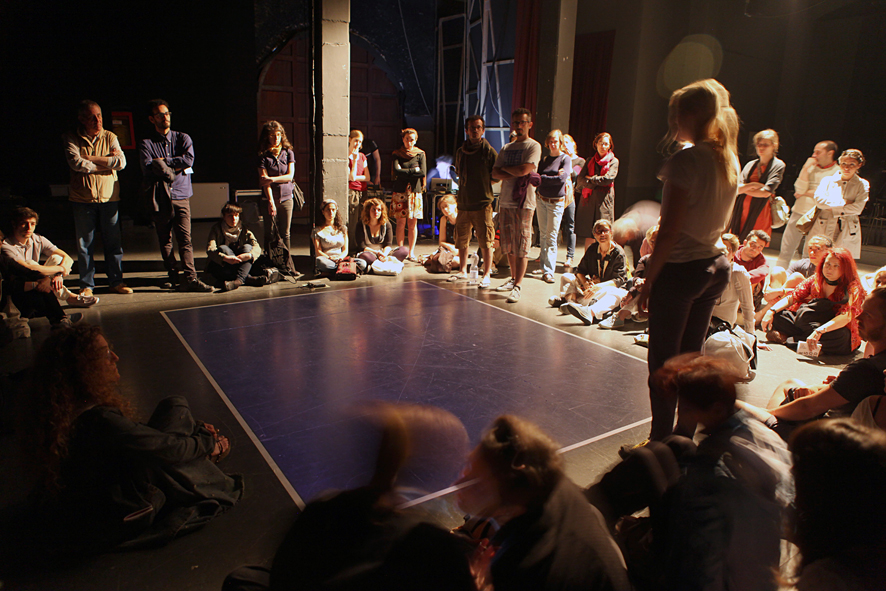
About
—
The Biennale of Young Artists from Europe and the Mediterranean was held for the first time in Barcelona in 1985 and was born from an idea of ARCI Kids, ARCI youth office. Its natural prologue was “Tendencias”, an initiative dedicated to youth cultural production in the Mediterranean area.
The Biennale was conceived, in its first editions, as a multidisciplinary meeting aimed at young under-35 artists from European and Mediterranean countries. The goal was to enhance their artistic production, allowing them to express their vision of the world. The organizers’ desire was to invest in the idea of youth creativity as a real resource, and not as a pure form of entertainment. The creative force of the young artists was therefore interpreted as a modality that allowed them to express themselves and their vision of reality; a means that identified professional alternatives for a generation that was not fully satisfied by traditional jobs, but above all the possibility of engaging in a political battle for its own realization.
The editions of the Biennale were the following:
Barcelona 1985, Thessaloniki 1986, Barcelona 1987, Bologna 1988, Marseille 1990, Valencia 1992, Lisbon 1994, Turin 1997, Rome 1999, Sarajevo 2001, Athens 2003, Naples 2005, Puglia 2008, Skopje 2009, Thessaloniki-Rome 2011, Ancona 2013, Milan 2015, Tirana-Durres 2017.
A creative path that has crossed eighteen editions, which has involved over 10,300 artists and more than 750,000 visitors. During these years the Biennale has been considered as the most important event for young artists (from 18 to 35 years old) in the Euro-Mediterranean space. Multidisciplinarity has always been one of its strengths: visual arts, applied arts, moving images, literature, gastronomy, music and performances are just some of the disciplines addressed by the various editions.
During the 1980s, 1990s and early 2000s, the Biennale was conceived as a true multidisciplinary happening. An international festival capable of mobilizing, for each edition, several hundred artists who for days – in some cases weeks – peacefully “occupied” the hosting cities, enriching them with their creativity. In recent times, in order to make the event more sustainable, the Biennale has changed shape, reducing the total number of artists involved and becoming not only a “showcase” for young Euro-Mediterranean artists, but also an opportunity for research, training, networking for the set up of transnational projects and much more.
The main event, in the last editions, was entrusted to high profile curators (Andrea Bruciati, who curated the 2015 edition of the Biennale in Milan who was, among other things, Director of the Institute Villa Adriana and Villa d’Este; or Driant Zeneli, curator of the 2017 edition of Tirana/Durres, who recently represented Albania at the Venice Biennale), in order to ensure a selection and an high-quality set-up.
Around the Biennale, especially in recent editions, collaboration opportunities have been built in various forms, from residency projects to training and research projects, from presentations of the results of European projects to workshops, actively involving both local communities and BJCEM members association. The Biennale can therefore be considered today as the culmination of a research project that accompanies young artists on their path of growth, no longer simply offering them an exhibition showcase, but giving them useful tools to become actors and protagonists of the dialogue in the Euro-Mediterranean area. A space that, in the last 30 years, has undergone profound changes, in front of which the Biennale has always managed to interface without being defeated. It has became an autonomous structure, a consolidated international network, where organizations can meet and people can learn how to recognize the Mediterranean region as a place of peace building, constantly creating dialogue between the people living around this area.
The Biennale of Young Artists from Europe and the Mediterranean is, even today, a launching platform for the career of the artists of the Euro-Mediterranean area. There are a lot of examples of names of established contemporary artists, who had their participation in the Biennale among their first experiences. This is the case, among others, of IRWIN, Grazia Toderi, Eva Marisaldi, Miltos Manetas, Vanessa Beecroft, Eulalia Valldosera, Adel Abdessemed, Vasco Araújo, Tobias Putrih, Erzen Shkololli, Mathieu K.Abonnenc, Ayreen Anastas, Giorgio Andreotta Calò, Haris Epaminonda, Coniglio Viola, Damir Očko, Valerio Berruti, Gian Maria Tosatti, Didem Erk, Ayman Ramadan, Elena Mazzi and Emilio Vavarella.